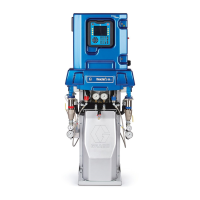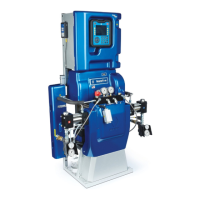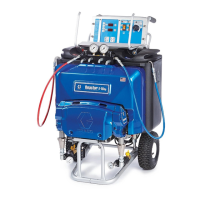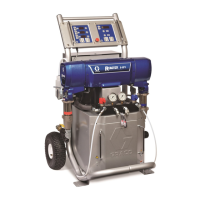Troubleshootin
g
Hose Heat Syst
em
Before performing any troubleshooting procedures:
1. Relieve Pressure. See Pressure Relief Procedure, page 49.
2. Turn main power switch OFF.
3. Allow equipment to cool.
Problem
Cause Solution
Ambient temperature is too cold. Relocate hoses to a warmer area
or recirculate heated fluid through
the hose.
FTS failed or not installed correctly. Check FTS, see Check RTD
Cables and FTS, page 72.
Low supply voltage.
Verify line voltage. Low line
voltage significantly reduces
power available to the hose heat
system, affecting longer hose
lengths.
Hose heats but heats slower
than usual or it does not reach
temperature.
If Hose Resistance Mode is
enabled, the calibration factor may
be inaccurate.
Re-calibrate the hose. Follow the
Calibration Procedure, page 75.
A and B setpoints too low. Increase A and B setpoints.
Hose is designed to maintain
temperature, not to increase it.
Ambient temperature is too cold. Increase A and B setpoints to
increase fluid temperature and
keep it steady.
Flow too high. Use smaller mix chamber.
Decrease pressure.
Hose was not fully preheated. Wait for hose to heat to correct
temperature before spraying.
Low supply voltage.
Verify line voltage. Low line
voltage significantly reduces
power available to the hose heat
system, affecting longer hose
lengths.
Hose does not maintain
temperature while spraying.
If Hose Resistance Mode is
enabled, the calibration factor may
be inaccurate.
Re-calibrate the hose. Follow the
Calibration Procedure, page 75.
4
4
333024N

